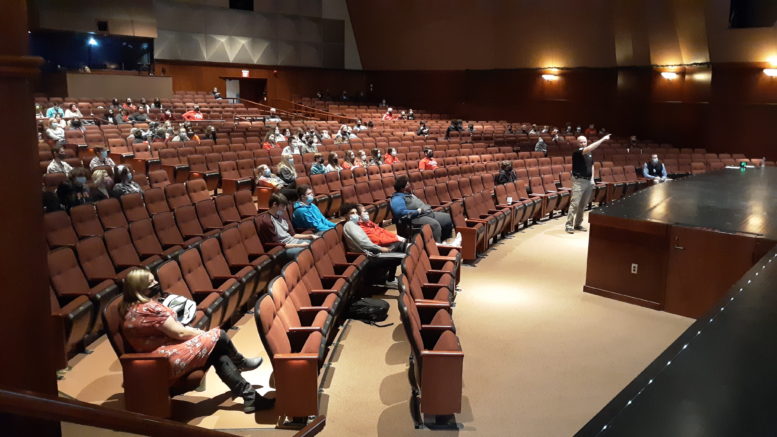By JAN LARSON McLAUGHLIN
BG Independent News
Captain Scott Frank spent Monday talking with all the students at Bowling Green High School about their “digital worlds.” In the evening, the students’ parents were invited to learn how to make sure their kids are safe in those worlds.
Fewer than 20 showed up.
“Shame on us. This should be standing room only,” Frank said to the parents scattered throughout the Performing Arts Center.
But Frank, a retired Ohio Internet Crimes Against Children investigator and now internet safety expert and empowerment speaker from Oak Harbor, said he was ecstatic that any parents showed up. His goal is to educate parents and empower kids.
As founder of the Digital Empowerment Project, Frank has presented to tens of thousands of students, parents and educators. The message he consistently hears from students is that they want to talk about their digital worlds.
“They want some help. They want some information,” he said.
Frank cautioned that even those parents high on the “geekometer” scale will be no match for most teenagers.
“We have this gap. I don’t know why we let this happen,” he said. “They are way more geeky than we are going to ever be.”
Parents come in a variety of types: Overwhelmed, complacent, enabling and educated. Inevitably, parents’ conversations about the internet begin with “Don’t do this …”
Instead, Frank said, all parents should start the conversation with their children like this – “I love you. Tell me about your digital world? How do you decide to accept a friend? What apps do you have?”
“Your kids are expecting a conversation,” he said, sharing topics he talked about with students during the day. “What a prime opportunity.”
He shared the story of one very tech savvy mom, who started the talk with her 12-year-old daughter, who confessed that she had been sending nude photos of herself to a guy online.
“It’s not easy being a kid in the digital world,” Frank said. “It’s not easy being a digital dad.”
Earlier on Monday, he had broken it to the students that those types of photos shared online tend to stay online. “Delete doesn’t always mean delete.”
For 11 years, Frank worked as a law enforcement officer posing online as a teenage girl. “Worst job ever – being a teen in the digital world,” he said.
The teenage girls he portrayed were stalked, mocked, bullied, flirted with, and frequently asked to send nude images. He shared mug shots of some of the men arrested for trying to hook up with young girls.
Kids are easy victims of exploitation online, Frank said. They are curious, tech savvy, and want affection and recognition.
“If you don’t parent your kids, the internet’s going to do that for you,” he said. They are vulnerable to people who shower them with attention, praise and “love.”
Anywhere from 12% to 20% of kids consider themselves to be in an “online relationship” with someone, he said.
As proof that kids make questionable choices online, Frank told the parents that prior to talking to their students on Monday, he spent two hours finding Bowling Green students online and sending them “friend” requests. Thirty-six students accepted the invitation.
“Who are they letting in their digital world?” he said.
Frank also talked about how requests with “cheerleader” type girls are accepted 100% of the time. While less attractive girls are turned down.
“That’s pretty shallow, but it’s true,” he said.
The average age of kids first being exposed to online pornography is 8. “It’s not a matter of if your kids are exposed to pornography. It’s a matter of when.”
“Your kids are constantly exposed to inappropriate material.” He talked about the high percentage of “barely dressed” females on Snapchat and TikTok. “That’s why our boys love TikTok.”
But it’s not just those types of dangers that worry Frank. He is also troubled by the fact that kids ages 8-12 spend an average of 4.4 hours a day on the internet, while those 13-18 spend an average 7.2 hours a day online.
“If we’re not careful, we’re going to lose a whole generation to internet mindlessness,” he said. “They can’t put their phones down.”
He referred to it as the “internet abyss.”
“This is an issue we are not talking about enough,” he said.
Some teens are suffering from addiction to the internet, experiencing depression, anxiety, threats, self-image issues, and a lack of real life balance in their lives, he said.
“The kids I talked to today are stressed” about their digital worlds, Frank said.
As he has traveled around talking with students and parents, Frank has found that parents want help. So he offers the following advice.
Strategy – First, parents should create a strategy – and that should be to address the child first, then the device. The strategy should be personalized for the child based on their social circle, “geek” abilities, level of obedience, and what is going on in their lives.
“Sometimes you need to take the internet away,” he said. But parents always need to give it back – since kids will find a way online with or without their parents.
“I want them to be in my supervised digital world, my supportive digital world.”
Talk – Next, parents need to talk with their kids and focus on the “big ask – Tell me about your digital world.” If kids don’t want to talk, “that is a red flag.”
“If your teen can’t go 24 hours without their digital world, you need to get on their phone,” he said. “You need to have the guts and the courage. That’s good parenting.”
Appropriate – Parents and children need to talk about expectations of screen time, types of devices, and what is being accessed. Frank said some children he talks with have no idea of their parents’ expectations.
Review – Parents are justified in having their children’s usernames and passwords. “Why are we giving teens access to 4.5 billion people,” with no parental guidance, he asked.
Frank said he always had the ability to look at his four kids’ internet activity – though he rarely used it.
“My kids always knew I could look. My kids could use me as an excuse,” he said.
Technology – Though it may be part of the strategy, parents shouldn’t rely on software to limit their children’s internet use. The kids will find a way around it, Frank said.
Find out about their apps. “We as parents need to understand the technology our kids have,” he said.
But focus on the child – not the technology.
Embrace – Teach children to embrace all the internet can teach them. “The internet rocks,” Frank said. Kids should be taught to use the internet to invest time in learning things, working to inspire others, and impacting their futures.
Frank told of one of his daughters who spend hours watching stupid pet tricks online – not exactly dangerous, but also not something worth hours of viewing. So they made a deal that for every hour she spent watching pet tricks, she spent another hour learning about a topic that interested her. She started learning about photography, and is now a professional photographer.
“We need to steer them in the right direction,” Frank said.





